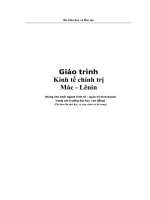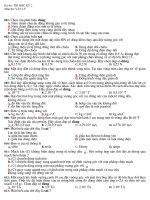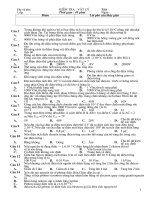KT Overview
Bạn đang xem bản rút gọn của tài liệu. Xem và tải ngay bản đầy đủ của tài liệu tại đây (508.75 KB, 20 trang )
<span class='text_page_counter'>(1)</span>THE MINISTRY OF EDUCATION AND TRAINING. LAWRENCE S.TING FOUNDATION. The E-Learning Contest – “The Geagraphy of Viet Nam” - - - - - - - - - -. Subject:. Grade:. An Overview about Kon Tum, The old days and Now Teachers: Dang Thi Hong Vy – Tran Thi Bich Thuy – Nguyen Thi Duong Contacts: 0977.096.905 – 0984.281.628 – 0123.76.79.799 Email: Nguy Nhu Kon Tum Primary Pedagogical Trial School – Kon Tum city October - 2016.
<span class='text_page_counter'>(2)</span> An Overview about Kon Tum, The old days and Now.
<span class='text_page_counter'>(3)</span> This is an English version of my E- learning lesson: "An overview about the old days and now". My lesson is designed for primary students from grade 3 to grade 5..
<span class='text_page_counter'>(4)</span> Aim After this have an Tum.. lesson you overview. will able to about Kon.
<span class='text_page_counter'>(5)</span>
<span class='text_page_counter'>(6)</span> Decide whether the following sentences are True (T) or False (F) 1. In the Bahnar language, Kon means “Lake" and Tum means "village". (F) 2. Kon Tum is a small province in the North of Central Highlands region of Vietnam.(T) 3. Kon Tum people worked in factories daily.(F) 4. Gia Lang was the leader of each village . (T) 5. The men’s clothes was “Xa Rong” and the women’s clothes was “Kho”. (F) 6. Kon tum became a French colony in 1913. (T).
<span class='text_page_counter'>(7)</span>
<span class='text_page_counter'>(8)</span> Project Planning Was the Plan the Right One? • Was the plan a good one? − What was good? What was missing?. • Was the plan realistic? • How did the plan evolve over time? − Was the change good or bad? − How did the changes affect the project?. • Key areas for improvement: − Make very specific recommendations..
<span class='text_page_counter'>(9)</span> Research & Development How Was R&D Managed? • How was the project managed through R&D? − How many teams, number of people, reporting structure, etc. − How well did that work? Improvements?. • How did the R&D teams communicate − What methods, timing, etc. − How well did that work?.
<span class='text_page_counter'>(10)</span> Research & Development How Effective & Efficient Was R&D? • Identifying & solving technical problems − Were issues identified early enough? − Were problems solved well? − What worked? Didn’t work? Could be better?. • Estimates & execution − Were estimates on track with actuals? − What helped people estimate well? − What caused people to estimate poorly?.
<span class='text_page_counter'>(11)</span> Project Management How Was the Project Managed? • Meetings: who/when/how often − How well did this work?. • Communication: who/when/how often − How well did this work?. • Changes: how tracked, communicated − How well did this work?. • Other methods: e-mail, schedules, databases,.
<span class='text_page_counter'>(12)</span> Manufacturing • Was team properly prepared to receive product? − BOM & paperwork complete & accurate? − Materials ordered & ready?. • Did product meet manufacturability goals? • Were there unexpected delays or problems?.
<span class='text_page_counter'>(13)</span> Quality Assurance & Support • How was product quality measured? − Was this effective? Efficient?. • How did final product compare against quality goals? • How were quality issues resolved? • Were support teams properly prepared? • Is product quality consistent with support resources?.
<span class='text_page_counter'>(14)</span> Marketing • Did positioning match final product? • Was positioning successful? Appropriate? Effective? • Was product launch effective? • Were marketing programs effectively implemented? • Did product & launch meet marketing goals?.
<span class='text_page_counter'>(15)</span> Sales • Was channel & sales force appropriately informed about product? • Did product and message meet customer need? • Was timing appropriate? Cost? • How do initial sales compare to goals? • How has product been received?.
<span class='text_page_counter'>(16)</span> Key Lessons.
<span class='text_page_counter'>(17)</span> What Went Right • Summarize in quick bullet points specific things that worked well − Use specific examples: “daily 15-minute morning status meetings worked well” rather than “team communicated well.” − Distribute or list network location of forms, procedures, reports, etc. that were found to be particularly useful..
<span class='text_page_counter'>(18)</span> What Went Wrong • Summarize in quick bullet points specific things that caused problems − Try to isolate specific attitudes, procedures, methods, timing issues, etc. which caused problems. • How did team respond to problems?.
<span class='text_page_counter'>(19)</span> Recommendations • By department or management level, record critical recommendations for future products of this type • Distribute document or network location of more detailed summary of this presentation.
<span class='text_page_counter'>(20)</span> Questions & Comments.
<span class='text_page_counter'>(21)</span>









